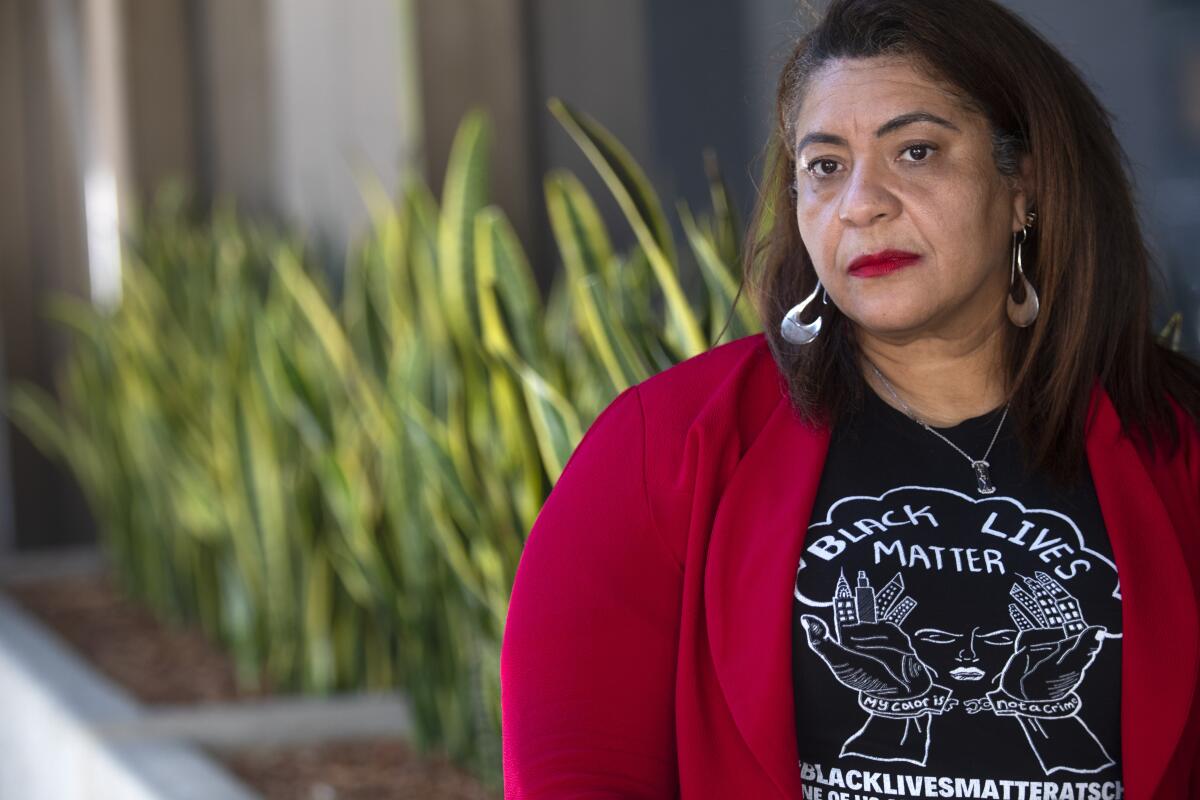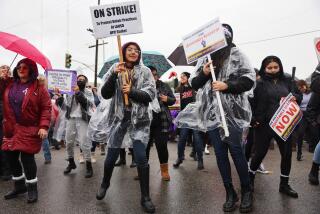L.A. teachers union opposes opening campuses for students with disabilities, English learners

Citing safety concerns, the leader of the Los Angeles teachers union said Friday it opposes reopening campuses for small in-person classes or one-on-one services for students who are disabled or learning English — even though county health officials have cleared the way to do so.
Some outside advocacy groups pushed back against the union’s position and the unwillingness of the L.A. Unified School District to address the issue directly and publicly.
“The students that have disproportionately suffered over the last several months in LAUSD are students with disabilities and English learners,” said Vanessa Aramayo, executive director of the local group Alliance for a Better Community. “They must be immediately prioritized and they must get the services they are entitled to legally. The learning loss is significant so there needs to be urgency.”
Cecily Myart-Cruz, president of United Teachers Los Angeles, said safety concerns for teachers had to take precedence and, she added, the union has the legal authority to veto any attempt by L.A. Unified to order any members of her union to work on campus. Her union also represents nurses and counselors.
“We know our students learn best in physical schools face to face with educators and the support providers they need and deserve, but UTLA stands strongly against any physical return to schools unless it is safe to do so for our members, students and the community we serve,” Myart-Cruz said. “And that is not the case at this point.”
Students with special needs for services such as speech therapy or orthopedic manipulation are among the children whose education has been most deeply hurt since the coronavirus-forced school closures. Many of them are unable to receive the hands-on services they need, and many parents cite regression in their children’s progress.
A similar scenario has unfolded for students who are learning English and need targeted academic help as many have limited support at home because their parents lack English skills.
Acknowledging this hardship, local health officials on Wednesday gave approval for L.A. County’s 80 public school districts to offer small-group, in-person instruction for these students. The county said their strict guidance for reopening schools must be followed for the in-person classes of no more than 12 students with two supervisors.
L.A. Unified declined to answer questions about UTLA’s position, including about whether the district favored bringing back small groups of students with special needs, which prompted concerns from a local advocacy group.
“There are legitimate questions about how the district will implement necessary safety measures, but we don’t believe silence from the district is acceptable when families and kids are in desperate need of help,” said Katie Braude, chief executive of the group Speak Up.
“We understand that there are both teachers and kids for whom the risk of a return to campus will be too great right now,” Braude said, “but a voluntary return for the highest-needs students should be allowed with safety measures in place.”
School systems are legally obligated to provide appropriate services to students with special needs, but the county and state have not ordered districts to bring these children back for in-person classes.
L.A.’s union — representing about 30,000 teachers, nurses, counselors and librarians — is among the unions up and down the state that negotiated agreements with their districts over distance learning and that are empowered to negotiate again over school reopenings.
Some smaller districts in L.A. County are making efforts to bring back students with special needs.
“We are assessing the logistics for bringing students ... in small cohorts,” said Kristine Nam, a spokeswoman for the Glendale Unified School District. “Plans will be made in collaboration with our unions.”
Glendale already has brought back some high-needs students for supervised online learning that doesn’t require direct in-person instruction from a teacher.
Alex Cherniss, superintendent at Palos Verdes Peninsula Unified, said he hoped to avoid union discord by stressing that teacher participation on campus would be voluntary. His plan is to pilot the small-group option by offering instruction to older disabled students with such classes as Transition to Independence and Life Skills.
“We will begin the process by working with those teachers willing to return,” Cherniss said.
Long Beach Unified School District, one of the state’s largest districts, is reviewing the guidelines, but “we don’t anticipate that formal negotiations will be needed for a return of students,” district spokesman Chris Eftychiou said. “We will, however, continue to collaborate with our labor partners.”
L.A. Unified responded to detailed questions from The Times with a one-sentence response: “Los Angeles Unified continues to work on plans for students to return to schools as soon as it’s safe and appropriate to do so.”
In remarks broadcast on Facebook, Myart-Cruz also took on other issues that underscored the challenge of distance learning. She said that the start of an ambitious school district plan to conduct widespread coronavirus testing and contact tracing had been delayed till after Labor Day. The district announced the effort three weeks ago.
L.A. Unified declined to comment or answer questions Friday on the status of its testing program.
Myart-Cruz also said there were important unresolved questions regarding aspects of distance learning. For example, she said, the district has not made it clear whether teachers are allowed to have one-on-one video conferences with students.
On campus, teachers have typically learned to have witnesses for meetings with students or to leave the classroom door open when they happen to be alone with a student. The goal is to avoid any appearance of impropriety and limit legal liability. Online meetings layer a new wrinkle onto this dynamic.
More clarity also is needed, Myart-Cruz said, on how to manage groups of students online. The videoconferencing platform allows teachers to place students in different online groups, allowing the teacher to “move” from group to group and work more directly with students. But does a different adult need to be supervising groups when the teacher is elsewhere?
L.A. Unified did not respond to questions about these issues.
More to Read
Start your day right
Sign up for Essential California for news, features and recommendations from the L.A. Times and beyond in your inbox six days a week.
You may occasionally receive promotional content from the Los Angeles Times.







